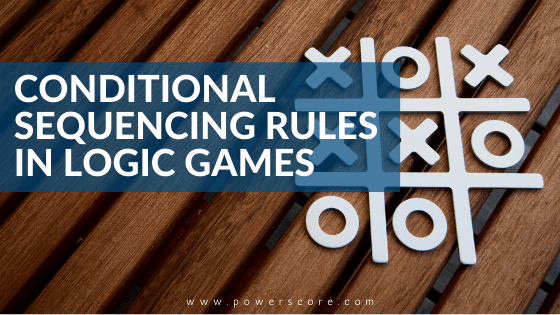We’re now ten weeks away from the LSAT, which still gives you plenty of time to prepare and reach your goals, but the clock is certainly ticking–if you’re waiting for your course to begin that’s fine!; if you haven’t thought about how you intend to prep, however, it’s time to get going.
And even though it’s still fairly early I regularly hear from anxious test takers, and unsurprisingly Logic Games often weigh most heavily on their minds. I devoted a recent blog post to the idea of creating templates for games, and today I want to tackle another commonly-confusing topic: rules that combine sequencing with conditionality.
The two ideas–sequences and conditional reasoning–are straightforward enough on their own, as any reasonably prepared student can attest.
Sequencing
For sequencing, a rule like “A is earlier than B” is simply diagrammed as “A — B,” representing the relative positions of the two variables with A to B’s left, and B to A’s right. Not Laws would also likely result, where B cannot be placed into the first position, and A cannot be in the last position (this assumes no ties, of course).
Conditionality
Similarly, for conditionality, a rule such as “if A is selected then B must also be selected” presents little challenge: a diagram with “A —> B” would be shown, and the contrapositive of “No B —> No A” (probably with slashes through the A and B) is also produced.
Example of Both
But what happens when you encounter rules with Conditional Sequencing? That is, rules with sequencing elements like “A earlier than B,” as well as conditional elements like “If A, then B”?
Let’s look at an actual example to get us started:
“If A is earlier than B, then B is earlier than C.”
Note the “earlier than” indicating a sequential relationship, and the “if…then” indicating a conditional relationship.
Diagrammatically we can show this as:
A — B —> B — C, and the contrapositive (assuming no ties) as C — B —> B — A
The problem for a lot of people is that they assume this means only one of two chains must happen:
1. A — B — C
2. C — B — A
And that’s true, but not the whole truth. That is, those two orders are both entirely acceptable from the rule, and either could occur. But because this rule is conditional in nature, those orders only apply when the initial condition of either the original rule (A — B) or the contrapositive (C — B) happens!
If the original condition does not occur (not A — B, so B — A), and the contrapositive’s first condition does not occur (not C — B, so B — C) then we can’t know anything and suddenly two other orders are allowed:
If B — A, then you could have C either earlier than B (#2 above), or
3. After A: B — A — C
4. Between B and A: B — C — A
So in fact we have four potential orders from that rule, not just two!
How to Make Sense of It
Fortunately, if that’s unclear there are a couple of other ways to think about this idea. For one, imagine the six possible orders of A, B, and C if no rules constrain their placement, and we don’t have ties.
1. A — B — C
2. A — C — B
3. B — A — C
4. B — C — A
5. C — A — B
6. C — B — A
Now think about which of those six orders would violate the conditional rule A — B —> B — C, or its contrapositive C — B —>B — A. Begin by isolating each instance where a sufficient condition (A — B, or C — B) occurs:
1. A — B — C
2. A — C — B
5. C — A — B
6. C — B — A
That happens in options 1, 2, 5, and 6. Options 3 and 4 don’t contain either sufficient condition, so can be ignored for the moment.
Now see which of the four options with a sufficient (A — B, or C — B) violate(s) the necessary (B — C, and B — A, respectively):
1. A — B — C
2. A — C — B
5. C — A — B
6. C — B — A
Note that options 2 and 5 are both violations of either the initial rule (#2) or the contrapositive (#5), so those two sequences, and ONLY those two sequences, are not allowed here. The other four (including numbers 3 and 4 above) are all fine.
Pay Attention to Non-Trigger Scenarios
Essentially the lesson then is that when dealing with conditional sequencing rules, and really conditional rules in general, you must pay attention to not only the scenarios that would trigger the rule (sufficient condition met), but also those that do not (sufficient not met), as those non-triggers represent situations that are possible until ruled out elsewhere. In the example here four possible orders, rather than just the presumed two, must all be taken into account as the game progresses!
These can be tricky ideas to get your head around at first, but with continued practice I promise they become much, much easier. So keep at it!
And if you have any questions or comments let us know below, or get in touch at (800) 545-1750.


Leave a Reply